Gorillas are one of the five great apes. The other four include humans, Orangutans, chimpanzees and bonobos. Gorillas are the largest of all the great apes and have a similar DNA to that of humans (95%). They not only exhibit compassion, happiness, sadness but can use complex tools like humans. The great  forests of East and Central Africa are the only natural habitat of gorillas in the world. These forests have different ecosystems with some comprising of montane forest, bamboo, rain-forests, wetlands, marshes and mountains.
forests of East and Central Africa are the only natural habitat of gorillas in the world. These forests have different ecosystems with some comprising of montane forest, bamboo, rain-forests, wetlands, marshes and mountains.
At one time, only one species of gorilla lived in one intact and vast tropical rain-forest. Overtime, it the forests became segmented due to natural factors but also population explosion in Africa. This single specie of gorilla got dispersed and had to adapt to different environments and patches of forest. They adapted different traits/behavior and physical structure. Despite their differences, it is very difficult to distinguish one subspecies of gorilla from another without experience observing them closely.
General Information about all Species of Gorillas
Gorillas are very large primates with adult males (Silverbacks) weighing over 150 kilograms and females about 120 kilograms. Their upper limbs are bigger and longer than the lower ones. Gorillas move on all two pairs of limbs but stand on two legs when picking food from high points. Gorillas have broad chests, 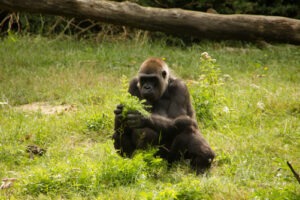 black/brownish eyes and large nostrils. Almost the entire body is covered by fur except for their faces, chest and ends of their digits. The hair on the back of the male turns grey as they mature and this why they are known as Silverbacks.
black/brownish eyes and large nostrils. Almost the entire body is covered by fur except for their faces, chest and ends of their digits. The hair on the back of the male turns grey as they mature and this why they are known as Silverbacks.
The average lifespan of a gorilla in the wild is 35 years and in captivity 45 years. Gorillas are very social animals with families/groups consisting of between 10 to 30 individuals. The family comprises of a dominant silverback, other silverbacks, two or three females, juveniles and infants. The dominant Silverback is the head of the family and determines everything that happens in the group. The stability of a gorilla family largely depends on the bond between the dominant male and adult females. Silverback gorillas are generally polygamous but all mating is initiated by the females as soon as they get fertile.
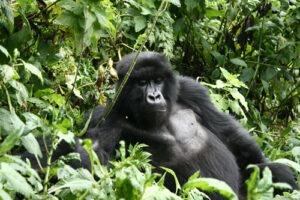 In-breeding is rare within a gorilla family. Young female gorillas normally join another families or look for a lone male gorilla once they reach sexual maturity. Adult males also tend to leave the group after being chased away by the alpha male silverback but this is not always the case. They will live alone in an area close to their original family or with other young silverbacks. While alone, the young silverback will try to steal females from another group. Female gorillas become sexually active at the age of 10 while males do the same at 15 years.
In-breeding is rare within a gorilla family. Young female gorillas normally join another families or look for a lone male gorilla once they reach sexual maturity. Adult males also tend to leave the group after being chased away by the alpha male silverback but this is not always the case. They will live alone in an area close to their original family or with other young silverbacks. While alone, the young silverback will try to steal females from another group. Female gorillas become sexually active at the age of 10 while males do the same at 15 years.
Gorillas are herbivorous animals that feed on tree shoots, leaves, vines and branches. They will occasionally eat small invertebrates for proteins. Gorillas spend most of their time on the ground feeding and preparing nests on the ground. Adult gorillas are good climbers but generally avoid trees because of their weight. It is the younger ones that love spending more time climbing trees. Gorillas are nomadic in nature. They keep moving from one place to another looking for fresh food or avoiding other families.
Note: Whereas gorillas are often mistaken for being beasts, they are arguably the most peaceful of primates. They are shy creatures and only get violent (charge) if they feel threatened in one way or another.
Gorilla Species
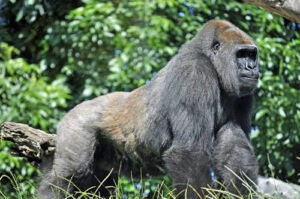 There are two species of gorillas found in the wild forests of Africa. They include the Eastern gorilla and Western gorilla. Gorillas are classified by their location. Western gorillas are generally found in the western arm of Africa’s tropical rain-forest while Eastern gorillas live in the eastern side. As earlier highlighted, gorilla species have minor physical differences. However, Eastern gorillas are slightly bigger than Western gorillas. Eastern Gorillas also have thicker fur covering their bodies. That said, there is a larger population of Western gorillas in the wilds of Africa compared to Eastern Gorillas. Western Gorillas are also the ones you see in zoos and sanctuaries outside Africa.
There are two species of gorillas found in the wild forests of Africa. They include the Eastern gorilla and Western gorilla. Gorillas are classified by their location. Western gorillas are generally found in the western arm of Africa’s tropical rain-forest while Eastern gorillas live in the eastern side. As earlier highlighted, gorilla species have minor physical differences. However, Eastern gorillas are slightly bigger than Western gorillas. Eastern Gorillas also have thicker fur covering their bodies. That said, there is a larger population of Western gorillas in the wilds of Africa compared to Eastern Gorillas. Western Gorillas are also the ones you see in zoos and sanctuaries outside Africa.
Gorilla Subspecies
There are two Gorilla Spies as highlighted earlier but each Specie is divided into two subspecies. Western gorillas are divided into the Western Lowland gorillas and Cross River gorillas. The Eastern Gorilla is divided into what is known as Eastern lowland gorillas (Grauer’s gorillas) and Mountain gorillas. We can now discuss the various gorilla sub-species in more detail:
The Grauer’s Gorilla or Eastern Lowland gorilla (G. beringei graueri): Eastern lowland gorillas or Grauer’s gorillas are a subspecies of the Eastern Gorilla. They are found in the eastern part of the 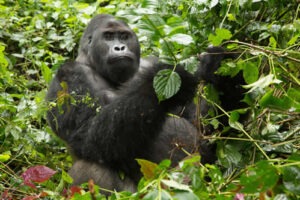 Democratic Republic of Congo. They can be sighted in Kahuzi Biega national park, Maiko National park, Itombwe Massif and Odzala-Kokoua national park. The Eastern Lowland Gorilla is the largest living primate or ape in the world. Although they are more numerous when compared to Mountain Gorillas, their numbers have declined more in recent years. There were over 20,000 individuals a century ago but now only about 7,500 individual remain. The best place to see these massive giants is in Kahuzi Biega and Maiko National Parks of the Democratic Republic of Congo.
Democratic Republic of Congo. They can be sighted in Kahuzi Biega national park, Maiko National park, Itombwe Massif and Odzala-Kokoua national park. The Eastern Lowland Gorilla is the largest living primate or ape in the world. Although they are more numerous when compared to Mountain Gorillas, their numbers have declined more in recent years. There were over 20,000 individuals a century ago but now only about 7,500 individual remain. The best place to see these massive giants is in Kahuzi Biega and Maiko National Parks of the Democratic Republic of Congo.
Mountain Gorillas (G. beringei beringei): Mountain gorillas may be the most widely known gorilla subspecies in the conservation world. They belong to the Eastern Gorilla specie and are found in the Virunga Ranges and Bwindi forest. The mountain gorillas generally live in areas of high altitude (between 8,000 and 12,000 feet). When compared to other gorilla sub-species, mountain gorillas have thicker fur to keep themselves warm since they live in colder areas.
The overall population of mountain gorillas is on the rise with over 1,000 individuals recorded in the wild. This rise is attributed to the fact they live in relatively safe and accessible national parks. More tourists visit mountain gorillas than any of the other gorilla subspecies hence attracting more conservation efforts/funds. Despite more exposure to tourism and conservation funding, they are still the second most critically endangered among the four sub-species. The best places to see Mountain gorillas is in the national parks of Bwindi and Mgahinga in Uganda. 30 percent live in the Volcanoes National Park in Rwanda and 20 percent in Virunga National Park of Congo.
Western Lowland Gorillas (G. gorilla gorilla): There are over 350,000 Western lowland gorillas left in the wild. They can be seen in the lowland tropical rain-forests of central and west Africa (Nigeria, Cameroon, Equatorial Guinea, Gabon, Democratic Republic of Congo, Angola and the Central African Republic). The Western Lowland gorilla belongs to the Western Gorilla specie. They are the smallest of all the subspecies of gorillas and have less fur on their bodies. Their fur is grey/reddish in color.
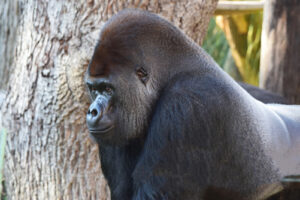 Western Lowland Gorillas are the ones you see in the different zoos and sanctuaries outside Africa. They can also be seen in the wild if you visit some national parks in west and central Africa. Though Western lowland gorillas are the most numerous, they are also endangered like any other gorilla subspecies. Their overall numbers have reduced more than any of the other subspecies. Over 60% of the overall population of Western Lowland Gorillas have been lost in the last three decades due to loss of habitat, poaching and outbreak of epidemic diseases like Ebola.
Western Lowland Gorillas are the ones you see in the different zoos and sanctuaries outside Africa. They can also be seen in the wild if you visit some national parks in west and central Africa. Though Western lowland gorillas are the most numerous, they are also endangered like any other gorilla subspecies. Their overall numbers have reduced more than any of the other subspecies. Over 60% of the overall population of Western Lowland Gorillas have been lost in the last three decades due to loss of habitat, poaching and outbreak of epidemic diseases like Ebola.
Cross River Gorillas (G. gorilla diehli): The Cross River Gorilla is a subspecies of the Western gorilla. They are larger than their closest cousins the western lowland gorilla. Their classification came more recently (2000) because it was always thought that the Western gorilla was one specie. Cross-river gorillas are scattered in small groups across lowland montane forests of Cameroon and Nigeria, an area 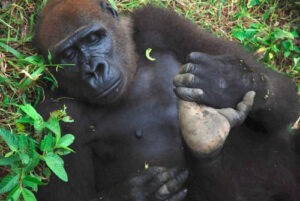 covering 3,000 square miles. They are the most critically endangered subspecies of gorillas and have an overall population of about 300 individuals in the wild. This low number is because they live close to human settlements. They have been decimated by loss of habitat, poaching and human diseases.
covering 3,000 square miles. They are the most critically endangered subspecies of gorillas and have an overall population of about 300 individuals in the wild. This low number is because they live close to human settlements. They have been decimated by loss of habitat, poaching and human diseases.
Cross River gorillas are more aggressive because of their frequent contact with humans. They face a lot of persecution and running battles with humans for space. This has forced the Authorities in Cameroon and Nigeria to gazette some areas as Cross River gorilla habitat. The two Governments work closely with international wildlife conservation Agencies to save the Cross River gorilla from extinction.
Note: Cross River Gorillas are not found in zoos and tracking is also not possible. The only way to see them is by visiting sanctuaries in Nigeria and Cameroon.
Additional Information – Endangered Status, Conservation and Gorilla Tourism
Gorillas are considered to be endangered and have been included in the red list of the International Union for Conservation of Nature (IUCN). Their overall population has declined drastically in the past two centuries due to loss of habitats, poaching and diseases. The loss of habitat has been caused by human encroachment on tropical rainforest, logging and other activities. Poaching, the lucrative pet/bush meat trade, especially in west Africa and Central Africa has also contributed greatly to the decline of gorilla populations. Apart from directing poaching, gorillas have also been accidentally killed by snares meant for other forest mammals. The outbreak of Ebola in West and Central Africa led to many gorilla deaths.
Although gorillas are an endangered species, we are glad to report that their overall population is now on the rise. The rise is attributed to the great efforts by the wildlife conservation organizations and the various governments where the gorillas live. Different strategies have been used to save gorillas from getting extinct. A strategy used by International Wildlife Conservation Agencies is to directly fund 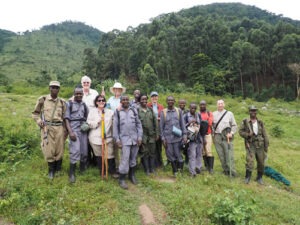 projects designed to protect gorillas. They have also initiated projects aimed at protecting the primates and the Eco-system in which they live. An example of such a project is that of treating sick gorillas in the wild by the Gorilla Doctors and Dian Fossey Fund International.
projects designed to protect gorillas. They have also initiated projects aimed at protecting the primates and the Eco-system in which they live. An example of such a project is that of treating sick gorillas in the wild by the Gorilla Doctors and Dian Fossey Fund International.
It is important to point out that Gorilla tourism has also contributed a lot to the rise in gorilla populations. Gorilla Trekking is expensive but it has attracted influential Tourists who have raised global awareness about the plight of gorillas and the need to protect them. Ordinary Tourists contribute indirectly to gorilla conservation by paying for the gorilla trekking permits. The revenue collected from permits is used to build infrastructure, train Rangers to protect gorillas from poachers and also employ the local people living close to the gorilla parks. It has been found out that when a community realizes the benefits of tourism, they are less likely to harm wild animals.
Note: Despite achieving great success, Wildlife Conservation Agencies still have to deal with the challenge of poaching, civil wars in the gorilla habitats, weak conservation law and corruption.


